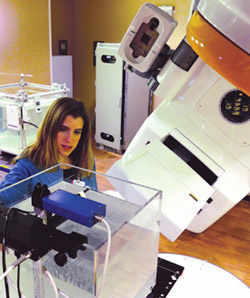The Scientists Driving Cancer Care
By Katianne Williams
A large team oversees an individual’s cancer care. There are nurses, radiation therapists, oncologists, and dosimetrists, and then there are medical physicists like Sheri Weintraub, chief physicist at a cancer care center in Fall River, Massachusetts.
NOTE: This is an abstract of the entire article, which appeared in the June 2011 issue of the IEEE Women in Engineering Magazine.
Click here to read the entire article.
While preparing for the opening of a new cancer care center, Weintraub uses water tanks to collect data from radiation
beams generated by a Varian Novalis TX linear accelerator.
As a medical physicist, Weintraub is responsible for the radiation safety of all of this clinic equipment and for the quality of the radiation treatments. Her work encompasses three critical spheres: checking patients’ individual treatment plans, performing quality assurance testing on existing pieces of equipment, and commissioning and safely integrating new technologies into clinical use. Over the last decade, technological advances in radiation therapy, imaging, and software have increased the need for smart, capable, dedicated medical physicists like Weintraub, and yet many people have never heard of the career.
A Little-Known Path
While an environmental science major at Rutgers University, Weintraub first became interested in radiologic science after taking a course in radiologic health. Then, while she was visiting career services one day, a stack of brochures from the American Association of Physicists in Medicine (AAPM) was literally dropped in front of Weintraub. She kept eyeing the brochure, although the career counselor discouraged her by saying that medical physics was “biology and medicine,” while Weintraub was a “math girl.” Undeterred, Weintraub found an internship working with the radiation safety officer at St. Peter’s Medical Center in New Brunswick, New Jersey. From there, Weintraub enrolled at the University of Cincinnati School of Medicine where she completed a two-year medical physics program, and she followed that up with a grueling three-part board certification process. As she says, “seeing the people depend- ing on your expertise and not being so many steps away from the direct results of your work makes it easier to work your tail off.”
Team Effort
When a cancer patient comes for radiation therapy, he or she is attended to by an entire team of experts, and Weintraub is quick to point out that each member brings an important and necessary skill set to the table. Together, they collaborate to provide the best possible care for their patients.
Each patient undergoes a series of CT scan and imaging tests, from which the radiation oncologist determines the course of radiation treatment – how much radiation to be applied and where it should be sent. From here, the radiation oncologist consults with Weintraub and a dosimetrist, and the dosimetrist, responsible for the radiation dose distributions, draws up a treatment plan. Weintraub is responsible for verifying and overseeing this plan. Always, Weintraub says, “the name of the game is applying the highest radiation dose to the target area and the least dose to anywhere else.” Using her knowledge of how radiation acts within different organs (be it lungs, bone, or soft tissue, for example), she confirms that the treatment plan presents the best outcome while mitigating side effects and damage to organs.
Lastly, Weintraub completes her quality assurance review by checking that the treatment plan data has been transferred correctly to the appropriate machine and by reviewing “beam on” times. After this point, if all goes perfectly, treatment begins.
Technological Advances
Outside of plan checking, patient chart checking, and quality assurance testing, Weintraub says that she is usually in the middle of commissioning something or bringing a new piece of technology or software into clinical use. Part of Weintraub’s job also involves knowing when and how to say no to flashy new products for which others might be pushing. She believes that the majority of recent changes in radiation therapy have not been to the hardware or the patterns of care themselves, but to advances in imaging and software to allow more precise real-time treatment decisions to be made. Tumors are in constant motion. For example, image guided radiation therapy (IGRT) is a now-mainstream advancement in imaging that equips the radiation therapy machines with imaging technology so that images can be acquired immediately before or even during treatment. Thanks to reduced radiation levels associated with IGRT, patients can be imaged daily as opposed to once or twice a week. This more frequent adaptation of treatment plans is called adaptive radiation therapy (ART), and with adaptive therapy coming into the mainstream, oncologists, dosimetrists, and medical physicists can constantly reevaluate and “tweak” treatment plans.
Real People Doing Real Work
Weintraub loves her career. She thinks what makes her a successful medical physicist is that family is her number one priority. As she says, her family fuels her. That is where she gets her energy and drive. From her family she finds the enthusiasm and passion and inspiration needed to do what she does. She describes herself as content and balanced. And, as chief, she looks for medical physicists who are also “real people that do real work.” Her job is at the intersection of science and humanity, and Weintraub feels fortunate to have stumbled across such a wonderful field. She cannot think of anything else she would be happier doing. What she loves about her job is how the physics skills and the mental tools she uses every day tie into something personally fascinating to her.







